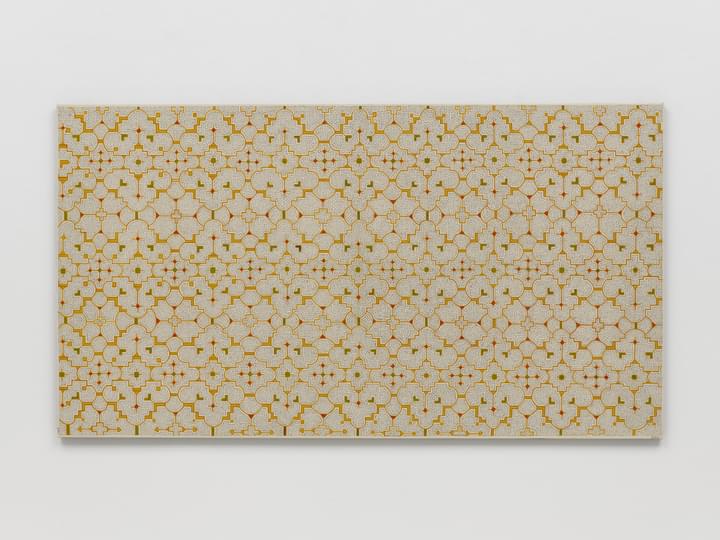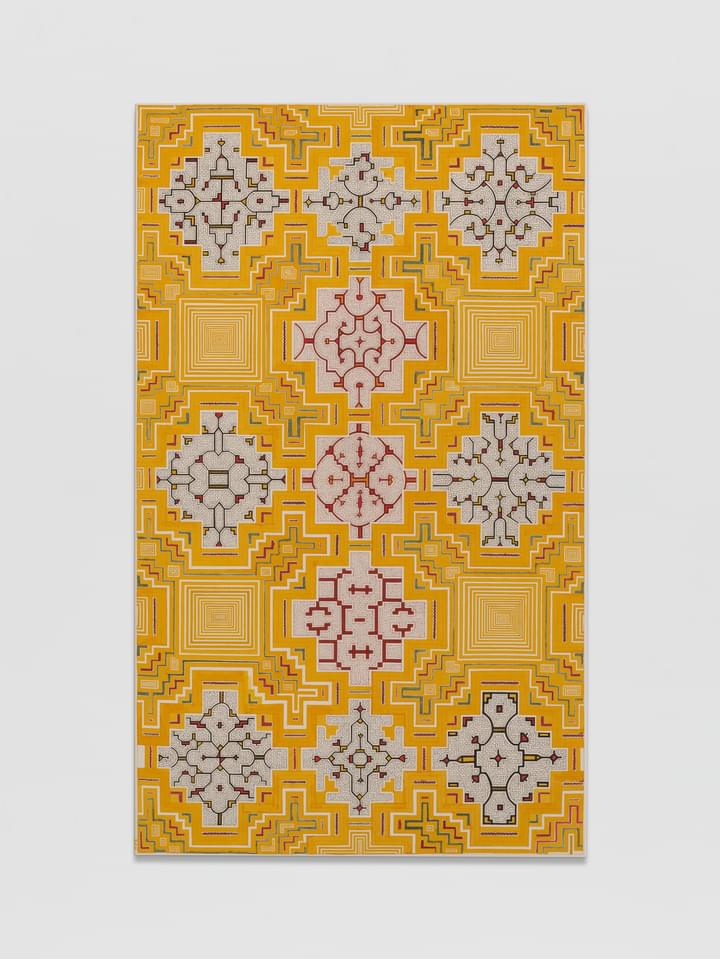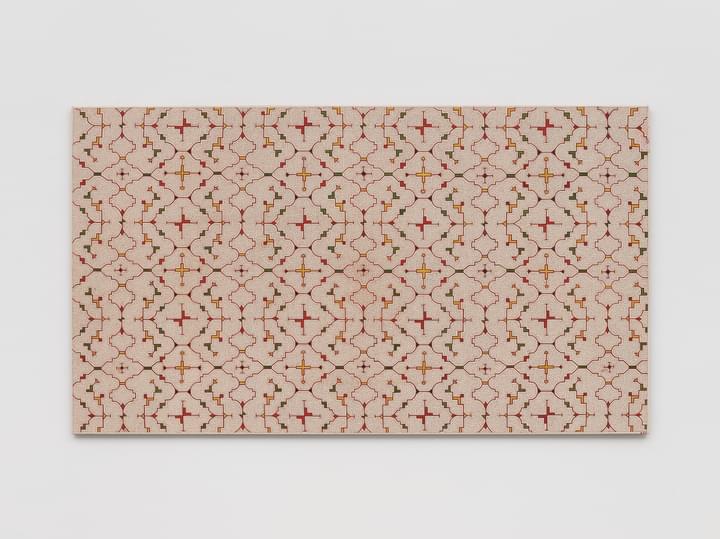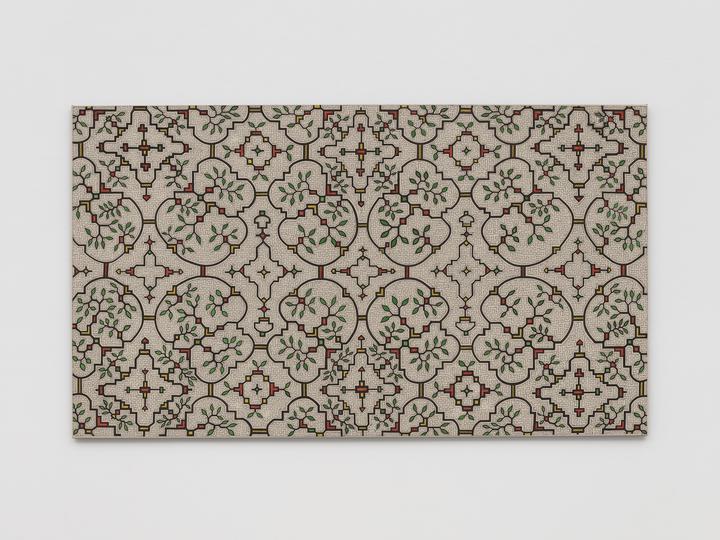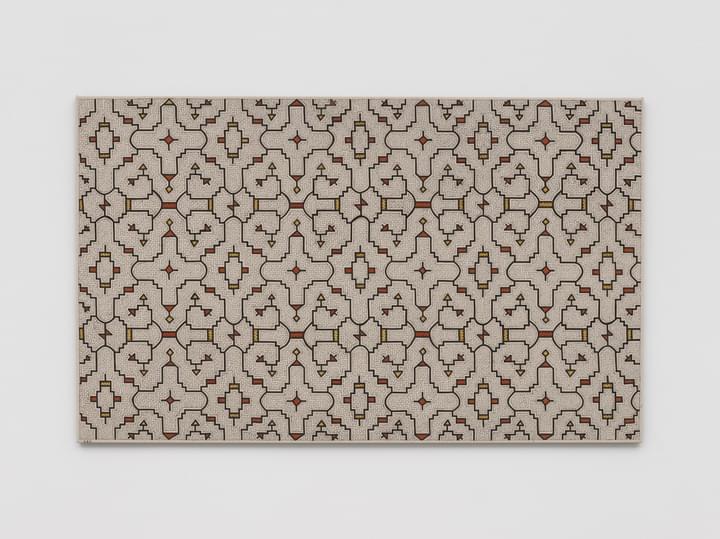
Sara Flores (Paris 2023)
Sara Flores
13 December 2023 – 13 January 2024
Dates
13 December 2023 – 13 January 2024
Kené is a Shipibo term that can mean 'design' and has etymological links to the verb kéenti, which means to love or to care for.
White Cube Paris is pleased to present an exhibition of Kené textile work by Sara Flores. Based in the Amazonian city of Pucallpa in rural Peru, Flores (b.1950) belongs to the Shipibo-Conibo, an Indigenous people who live along the Ucayali River. Flores is recognised locally and internationally for her masterful Kené, an ancient medium that is central to the artistic expression and cultural heritage of the Shipibo-Conibo.
The Shipibo-Conibo communities share a worldview of reciprocity that recognises the interdependence of all life forms. Intricately geometrical and rhythmically tessellated, Kené designs serve as gateways to this belief system and its ancient knowledge. Kené is a Shipibo term that can mean 'design' and has etymological links to the verb kéenti, which means to love or to care for. The labyrinthine patterns of Kené result from the Shipibo-Conibo’s ritual of the ayahuasca ceremony, and the consumption of other psychoactive plants such as Kené Wáste that expand individual consciousness and give access to the source of the visions. Through this process, the Shipibo-Conibo attest to the making of Kené as an inherently healing act, its complex symmetry and nuanced trajectories reflecting conditions of harmony and serving to restore inner peace.
Without a defined orientation, the design of Kené is valued for its expertly winding rhythms and playful direction of extended form-lines (peshtin). Flores’ work is exemplary in this regard, as it executes a purposeful trajectory of strokes from which finer traceries (kétana) emerge, while nested within these empty spaces are precisely formed filler motifs (weshé). Continuously experimenting within this codified structure, Flores’ work demonstrates a particular ability to create mashcata within her designs, an asymmetric variation residing within symmetrical arrangements, which become the inspiration for a new pattern. A direct transferral of embodied visions, Flores’ Kené harmonise technical accuracy with inherited knowledge and the vitalising experiences of plant-medicine rituals.
Embedded within the intergenerational knowledge and curative potential of Kené is its attribution to Ronín, the cosmic anaconda spirit known as the mother and guardian of rivers, and whose skin contains infinite designs. In her command of the protean line, Flores invokes this spirit while developing lattices that recall the mutually generative principles of networks whether neural, psychological, elemental or ecological. Equally, Flores’ patterns express the energy of growth, evoking the fragile vascular geometries of leaves or the conflux of climbing vines, the fractal filigrees of each summoning botanical, even cellular, ecosystems.
Flores sources all the materials for her Kené by hand, creating dyes from plants found in her immediate environment which are applied to tucuyo, a canvas made from wild cotton. For the black peshtin, the bark from three trees is blended, two of which derive from one river delta and the other from the highlands. Reduced to a brown tincture, the dye is initially applied and then washed off the canvas with a clay solution which transforms and sets the colour to black. Other polychrome dyes are prepared from autochthone flora, including the leaves of the Amí for purple, the fruit of the Achiote for red, and the root of the Guisador for yellow. Here, Kené establishes a direct connection with the land of the Shipibo-Conibo and becomes a way for the spirit of its flora and trees to endure.
Functioning as a window onto infinite space, Kené presents the fluid forms and images that inhabit the spiritual world using knowledge passed down through the matriarchal line, from one generation to the next. From a young age, Flores was trained in the art of Kené by her mother and her role now exemplifies the term of joni-ati or ‘person making’ in the Shipibo-Conibo community where she is assisted by her daughters. Flores explains that in her process ‘the hand goes by itself, and inspiration emerges.’ Masterfully consolidating the two main powers of Kené: menin and shinan, her work combines mature skill with intuitive expression and unfathomable visionary imagination. ‘Menin, the technical aspect, can be learned’ she explains, ‘Shinan, the visionary aspect, cannot. You either have shinan, or you don’t.’ Always drawn by hand, in free-form without the use of rulers or preparatory studies, her Kené start with a few strokes and soon elaborate intuitively, akin to the process of automatic writing.
Kené was declared part of the National Cultural Heritage of Peru in 2008. An emblem of artistic resistance, Kené asserts the Shipibo-Conibo People’s defiance of colonial forces that have resulted in ecological destruction and environmental pollution. Flores’ enigmatic work articulates Indigenous ethics and the urgent need for ecological conservation while demonstrating the transformative potential of artistic creation.
This exhibition is a collaboration with the Shipibo-Conibo Center, New York. The Center is an art project in the form of a nonprofit organisation that works alongside Indigenous leadership in the Amazon toward Shipibo self-determination and territorial sovereignty in a sustainable future.
Sara Flores (b.1950) lives and works in Peru, and is part of the Shipibo-Conibo, an Indigenous people spread out alongside the Ucayali River.
Selected recent solo exhibitions include: White Cube Paris (2023); CLEARING, New York (2023); CLEARING, New York (2022); White Cube Online (2021); and Outsider Art Fair, New York (2020). Selected group exhibitions include: Musée du Quai Branly-Jacques Chirac, Paris (2023); Para Site, Hong Kong (2023); El Museo del Barrio, New York (2023); Museum Voorlinden, Wassenaar, Netherlands (2023); Inca Garcilaso Cultural Center of the Ministry of Foreign Affairs of Peru and MAC Museum of Contemporary Art of Lima, Peru (2022); Sala Luis Miró Quesada Garland, Miraflores, Lima (2021); Drawing Lab, Centre d’art privé dédié au dessin contemporain, Paris (2020); and Austrian Cultural Forum, New York (2018).
Create an Account
To view available artworks and access prices.











